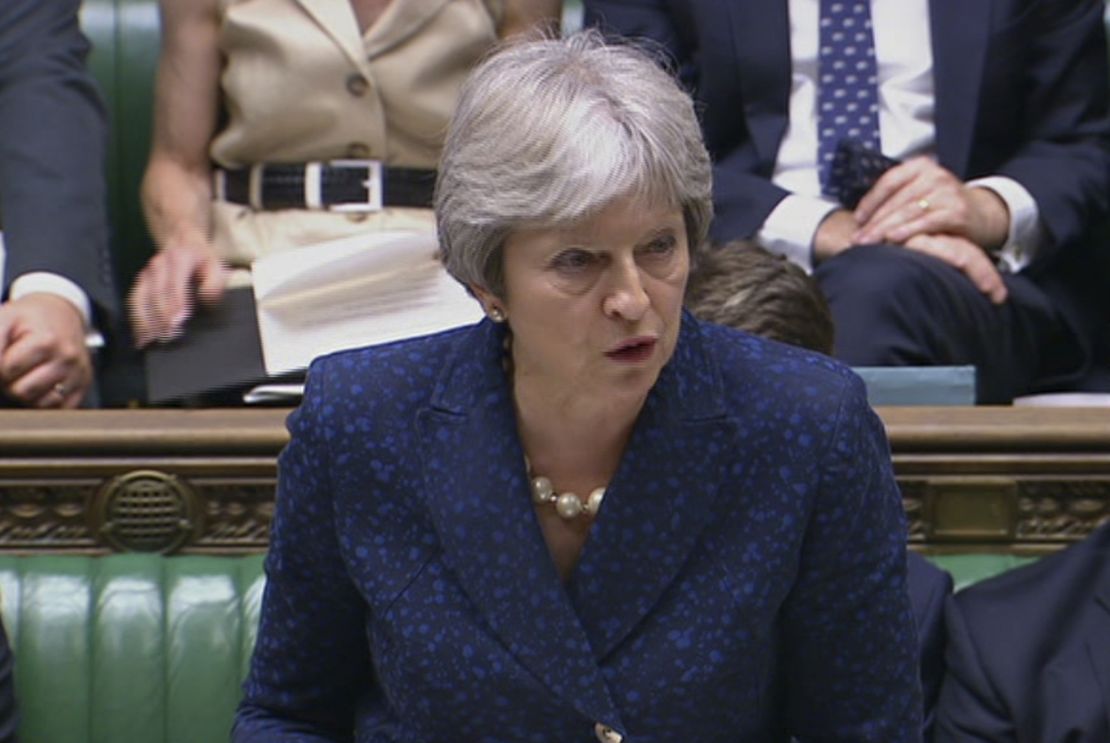Editor’s Note: Jane Merrick is a British political journalist and former political editor of the Independent on Sunday newspaper. The opinions expressed in this commentary are hers.
Given the turbulent period Theresa May has been experiencing over the past fortnight, she could be forgiven for thinking that the forthcoming summer break, when the UK Parliament does not sit for six weeks, has not come soon enough.
In the space of less than a month, the Prime Minister has survived, so far, high-profile Cabinet resignations, calls from her own members of Parliament for a vote of confidence in her leadership and knife-edge votes in the House of Commons on key parts of her Brexit strategy.
A deal between the UK and the European Union on Brexit has not been reached – not least on the key sticking point of a border in Ireland, which remains far from resolved. The UK government is poised to issue advice to the public about how to prepare for a no-deal Brexit, as well as instructing health officials to stockpile medicine and planning emergency measures to ensure mass transit runs smoothly. In short, Donald Trump had a point when he said that Britain is in turmoil.

The crisis of the last few weeks in British politics was always going to be unavoidable, but the timing is all the PM’s fault. May has spent two years putting off a showdown with her own party – which is split between those who are staunchly pro-Brexit and want to sever all links to the EU, and those who want to keep some aspects of membership.
When she gathered her Cabinet ministers for a meeting at her country residence of Chequers earlier this month, to finally achieve a compromise deal to put forward to Brussels, there was lukewarm support – and the deal ultimately led to the resignation of Foreign Secretary Boris Johnson and Brexit Secretary David Davis.
Related: Theresa May Is Running Out Of Options On Brexit
The Prime Minister had little choice but to try to reach agreement within her own government; otherwise Britain would be leaving the EU next March without a proper deal. Her problem is that she should have acted much quicker to achieve unity in her party. This ongoing crisis erupted just days before the long summer recess, when many MPs escape London for the beach and government ministers are required to do the bare minimum as holiday cover.
At this moment of paralysis in British politics, it is, surely, a mistake for the Prime Minister to treat this summer break as any other. The idea that there will be six weeks when MPs cannot debate Brexit laws in the Commons is staggering, considering the tight timetable of the Brexit process.
All outstanding problems – including the most controversial and intractable, the Irish border question – are supposed to be solved by October, when the EU expects a final deal to be reached on what Brexit will look like, including the UK’s ongoing relationship with Brussels. In the last few days, May traveled to Northern Ireland to make it look like she’s getting to grips with the border issue, but it is hard to see how the problem can be resolved.
The UK and Irish government and negotiators in Brussels all want to avoid a hard border between Northern Ireland, which as part of the UK would be outside the EU after Brexit, and the Irish Republic, which will remain a member. There remains disagreement on how this scenario is avoided, with Brussels proposing a backstop if a proper arrangement is not in place by December 2020.
Under this backstop measure, Northern Ireland would remain inside the EU’s customs union and large parts of the single market. The problem is that the UK government is opposed to this plan because a new border would be created in the Irish Sea between Northern Ireland and the rest of the UK. In her speech in Belfast on Friday, May warned Brussels negotiators to “evolve” their position on Brexit or else a deal would not be reached.
Related: Britain’s Prime Minister Theresa May survives crucial Brexit vote
Yet the overall Chequers plan has already been criticized by the EU’s chief negotiator, Michel Barnier, who said it undermines the “fundamental” principles of the EU because the UK still sought to cherry-pick aspects of single-market membership.
Speaking in Brussels on Friday, Barnier called for urgent clarity on the issue, saying that the debate over the UK’s Brexit plan “is not over yet” – a clear sign that the EU sees it as an opening bid, rather than a final deal.
Warning that there are only 13 weeks left before a deal should be reached, Barnier said: “We cannot afford to lose time on this issue and this is why we have invited the UK to work on the backstop next week. We are open to any solutions as long as they are workable and can be transformed into a legally operative text in time for the withdrawal agreement.
This impasse is even before all the other EU nations have agreed to the plan. There is a long way to go before Brexit is solved, so a long holiday for British politics is the last thing the UK needs.


















